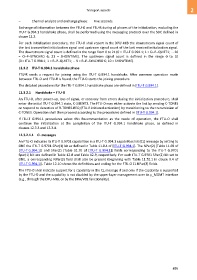Page 905 - 5G Basics - Core Network Aspects
P. 905
Transport aspects 2
– Channel analysis and exchange phase: Five seconds.
Exchange of information between the FTU-O and FTU-R during all phases of the initialization, excluding the
ITU-T G.994.1 handshake phase, shall be performed using the messaging protocol over the SOC defined in
clause 12.2.
For each initialization procedure, the FTU-O shall report in the DPU-MIB the downstream signal count of
the last transmitted initialization signal and upstream signal count of the last received initialization signal.
The downstream signal count is defined in the range from 0 to 21 (0 = ITU-T G.994.1; 1 = O–P–QUIET1; ... 20
= O–P–SYNCHRO 6; 21 = SHOWTIME). The upstream signal count is defined in the range 0 to 10
(0 = ITU-T G.994.1; 1 = R−P−QUIET1; … 9 = R–P–SYNCHRO 6; 10 = SHOWTIME).
12.3.2 ITU-T G.994.1 handshake phase
FTU-R sends a request for joining using the ITU-T G.994.1 handshake. After common operation mode
between FTU-O and FTU-R is found, the FTU-O starts the joining procedure.
The detailed procedures for the ITU-T G.994.1 handshake phase are defined in [ITU-T G.994.1].
12.3.2.1 Handshake – FTU-O
An FTU-O, after power-up, loss of signal, or recovery from errors during the initialization procedure, shall
enter the initial ITU-T G.994.1 state, C-SILENT1. The FTU-O may either activate the link by sending C-TONES
or respond to detection of R-TONES-REQ (FTU-R initiated activation) by transitioning to the transmission of
C-TONES. Operation shall then proceed according to the procedures defined in [ITU-T G.994.1].
If ITU-T G.994.1 procedures select this Recommendation as the mode of operation, the FTU-O shall
continue the initialization at the completion of the ITU-T G.994.1 handshake phase, as defined in
clauses 12.3.3 and 12.3.4.
12.3.2.1.1 CL messages
An FTU-O indicates its ITU-T G.9701 capabilities in a ITU-T G.994.1 capabilities list (CL) message by setting to
ONE the ITU-T G.9701 SPar(1) bit as defined in Table 11.0.4 of [ITU-T G.994.1]. The NPar(2) (Table 11.69 of
[ITU-T G.994.1]) and SPar(2) (Table 11.70 of [ITU-T G.994.1]) fields corresponding to the ITU-T G.9701
Spar(1) bit are defined in Table 12-8 and Table 12-9, respectively. For each ITU-T G.9701 SPar(2) bit set to
ONE, a corresponding NPar(3) field shall also be present (beginning with Table 11.70.1 in clause 9.4 of
[ITU-T G.994.1]). Table 12-10 shows the definitions and coding for the FTU-O CL NPar(3) fields.
The FTU-O shall indicate support for a capability in the CL message if and only if the capability is supported
by the FTU-O and the capability is not disabled by the upper layer management over its γ_MGMT interface
(e.g., through the DPU-MIB, or by the DRA/VCE functionality).
895

